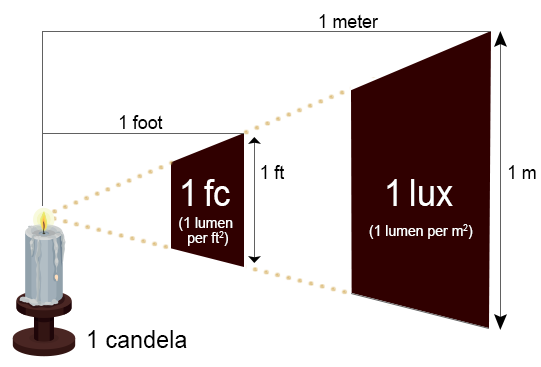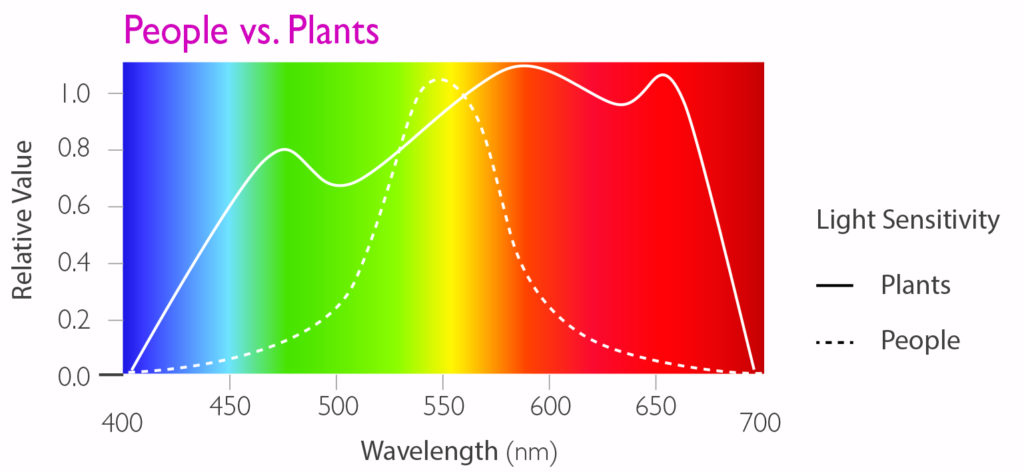Choosing the right horticultural lighting for your greenhouse or indoor grow can seem overwhelming, especially when considering all the lighting options available. While choosing the most practical horticultural lighting is important, there are several factors you need to consider, including color temperature, lumens, footcandles, PAR, and PPFD. Although all these terms are useful for describing lighting, they are not all useful from the plant’s perspective. In this article, we will offer insight into these concerns and explain which metrics are important for your plants.
First, we must understand how humans and plants perceive light differently.
Light perception variance between humans and plants
The human eye has different light receptors than a plant. As a result, how we describe light is biased toward the type of light we can see. While plants see photosynthetic photon flux, humans see lumens. Our eyes are most sensitive to yellow and green light, good at seeing red and blue light, and nearly incapable of perceiving infrared and ultraviolet light. By contrast, plant photoreceptors are great at perceiving blue and red light and can detect many other spectrums, including ultraviolet and infrared light.
Human Perception of Light
Candela is the basic unit of measure of light intensity from any point in a single direction from a light source.
Lumen (lm) is the basic unit of measure for light visible to the human eye. If a uniform point source of 1 candela is at the center of a sphere with a 1 ft2 radius and an opening of 1 ft2 at its surface,  the quantity of light that passes through that opening equals 1 lumen. Since lumens are a photometric measurement for humans, we do not use this unit of measure to describe horticultural lighting.
the quantity of light that passes through that opening equals 1 lumen. Since lumens are a photometric measurement for humans, we do not use this unit of measure to describe horticultural lighting.
Illuminance refers to the density of light over a given surface area and is expressed in either lux or footcandles:
Lux (lx) is a photometric unit that describes the number of lumens visible in a square meter. 100 lumens spread out over 1 m2 will have an illuminance of 100 lx. The same 100 lumens spread over 10 m2 produces a dimmer illuminance of only 10 lx.
A footcandle describes the number of lumen per square foot. Therefore, one footcandle is equal to approximately 10.764 lx. This measure is only relevant to how we perceive light and is irrelevant to plant growth. Like lumens, lux and footcandles are not useful for describing horticultural lighting.
Color Rendering Index (CRI) describes the ability of a light source to show an object’s color accurately compared to standardized color samples under a reference light source. The highest value a light can achieve is a CRI of 100. Lower CRI values result in objects appearing unnatural or discolored. Under a light with a CRI of 100, an orange appears bright orange. Under a light with a CRI of 70, the orange appears darker and bluer. This measure depends on how the human eye sees light, making it an unuseful parameter for choosing horticultural lighting.
Correlated Color Temperature (CCT) describes the color of a light source vs. a reference source when heated to a particular temperature. CCT is measured in degrees Kelvin (°K). The higher the CCT of a light source, the cooler the light’s color. For example, a very red light achieves a CCT of about 1000 K while a very blue light can achieve a CCT of about 10,000 K. Warm white lights will have a CCT of around 2700 K (since they emit more energy at the red end of the spectrum), neutral white will be around 4000 K, and cool white around 5000 K (emitting more energy at the blue end of the spectrum). Similar to CRI, this measure depends on light perception by the human eye. Once again, it is not useful for describing or choosing horticultural lighting.
Plant Perception of Light
Plants use the electromagnetic spectrum for photosynthesis, known as Photosynthetically Active Radiation (PAR), which encompasses the wavelengths from 400 nm (nanometers) to 700 nm. In addition to the spectral range of PAR, we also understand plants can detect wavelengths of light outside of this range, including ultraviolet and infrared wavelengths.
We mentioned earlier that lumens measure the amount of light emitted by a source, which is visible to the human eye. For plants, we use a term called Photosynthetic Photon Flux (PPF), which describes the quantity of PAR produced by a source per second. This measurement is expressed in micromoles per second (µmol/s). PAR is an important quantum parameter when considering horticultural lighting, but PPFD is more essential.
While lux and footcandles describe the amount of human-perceived light per unit area, Photosynthetic Photon Flux Density (PPFD) represents the amount of light (intensity) useful for photosynthesis (PAR) that arrives at the plant. PPFD is given in units of micromoles of photons in the PAR range delivered to one square meter per second (µmol/s/m2 or µmol s-1m–2). It is the most important value for growers to focus on while comparing lights. PPFD must be measured at a defined height since it decreases as you move further away from the light source. Ideally, PPFD is also measured over a defined area, as most lights are brightest directly below the source and have reduced intensity as you move further away.
Light Distribution
To ensure all plants have similar yields, the light distribution must be as uniform as possible throughout the growing area. Light distribution describes the direction and intensity of light emitting through a luminaire. The distribution pattern is determined by the height and angle of the lamp. As the height of the grow lamp above the canopy increases, light intensity decreases while light distribution angle increases. Lighting manufacturers publish photometric distribution diagrams for their luminaires, which provide a visual guide to the type of distribution expected.
 |
 |
 |
The Alpha, Beta, and Asymmetric curves above illustrate the distribution of luminous intensity, for the transverse and axial planes of the luminaire. The light source is located at the center, and the lines radiating from the center depict the angle decreasing light intensity as distance from the light source increases.
Daily Light Integral
We will end with a mention of Daily Light Integral (DLI), a parameter describing the cumulative PPFD over an entire day.1 A grower can think of DLI as the plant’s daily light dose. DLI is strongly and positively related to photosynthesis, growth rate, and overall plant productivity. The units for DLI are similar to that of PPFD but extend over an entire day (µmol/d/m2 or µmol d-1m2). The value for DLI will depend on the intensity and duration of light the plants receive. For example, a plant that receives 100 µmol s-1m-2 over a 10-hour photoperiod will have a DLI of 3.6 mol/d/m2. If we extend the time our light is on to 14 hours, we are now delivering a DLI of 5.0 mol/d/m2. With that in mind, DLI remains an important parameter for a grower to consider when purchasing horticultural lighting.
The next time you compare horticultural lighting options for your greenhouse or indoor grow, keep these horticultural lighting parameters in mind.
Citation
Written by – Steve Szewczyk is the Regional Sales Manager of North East U.S. & Eastern Canada. With years of industry experience, Steve is passionate about helping growers maximize their yields. Contact Steve.




